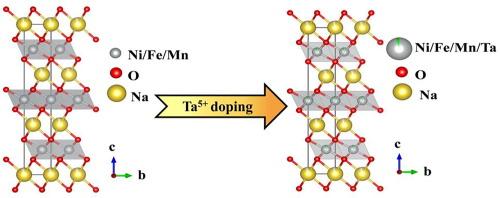Deciphering the function mechanism of high-valence tantalum doping in O3-types layered cathode for sodium-ion battery
IF 14.9
1区 化学
Q1 Energy
引用次数: 0
Abstract
O3-types layered cathode materials in sodium-ion batteries (SIBs) suffer from the obvious lattice distortion induced by the complex phase transitions during Na+ intercalation/deintercalation process, leading to severe structural collapse and performance degradation. Herein, a series of high valence tantalum (Ta5+) doped Na(Ni0.4Fe0.2Mn0.4)1−xTaxO2 (x = 0/0.0025/0.005/0.01) secondary spherical particles are firstly developed, where Ta5+ doping enables the refined primary grain with a tightly stacked rod-like morphology. Comprehensive structural analysis via Neutron powder diffraction (NPD) and Synchrotron radiation X-ray diffraction (SXRD) reveals an expanded NaO2 slab and a reduction in Na site vacancy. The potential charge compensation mechanism is further illustrated by X-ray absorption spectroscopy (XAS) and X-ray photoelectron spectroscopy (XPS), unveiling a partial reduction from Ni3+ to Ni2+ with Ta5+ doping. In situ X-ray diffraction (in situ XRD) suggests that the decorated sample undergoes a volume change as low as 0.8 %, in contrast with the pristine one (1.5 %). Thus, the optimized sample with x = 0.005 retains an enhanced capacity retention up to 70.4 % at 1 C after 300 cycles in half-cell and delivers a high energy density of 251 Wh kg−1 (0.1 C) and with a good capacity retention of 81.0 % at 1 C after 200 cycles in full-cell. Our findings provide new insights into the mechanism of high valence Ta5+ doping in stabilizing layered oxides cathode materials for SIBs.

钠离子电池o3型层状阴极中掺杂高价钽的作用机理
钠离子电池(sib)中o3型层状正极材料在Na+插入/脱嵌过程中由于复杂的相变导致晶格畸变,导致结构严重崩溃,性能下降。在此基础上,首先形成了一系列高价钽(Ta5+)掺杂的Na(Ni0.4Fe0.2Mn0.4)1−xTaxO2 (x = 0/0.0025/0.005/0.01)二次球形颗粒,其中Ta5+的掺杂使初生晶粒细化,具有紧密堆积的棒状形貌。通过中子粉末衍射(NPD)和同步辐射x射线衍射(SXRD)的综合结构分析表明,NaO2板扩大,Na位空位减少。x射线吸收光谱(XAS)和x射线光电子能谱(XPS)进一步阐明了电位电荷补偿机制,揭示了Ta5+掺杂后Ni3+部分还原为Ni2+。原位x射线衍射(In situ XRD)表明,与原始样品(1.5%)相比,装饰样品的体积变化低至0.8%。因此,当x = 0.005时,优化后的样品在半电池中循环300次后,在1℃下的容量保留率高达70.4%,在全电池中循环200次后,其能量密度高达251 Wh kg−1 (0.1 C),容量保留率为81.0%。我们的研究结果为稳定sib层状氧化物正极材料的高价Ta5+掺杂机理提供了新的见解。
本文章由计算机程序翻译,如有差异,请以英文原文为准。
求助全文
约1分钟内获得全文
求助全文
来源期刊

Journal of Energy Chemistry
CHEMISTRY, APPLIED-CHEMISTRY, PHYSICAL
CiteScore
19.10
自引率
8.40%
发文量
3631
审稿时长
15 days
期刊介绍:
The Journal of Energy Chemistry, the official publication of Science Press and the Dalian Institute of Chemical Physics, Chinese Academy of Sciences, serves as a platform for reporting creative research and innovative applications in energy chemistry. It mainly reports on creative researches and innovative applications of chemical conversions of fossil energy, carbon dioxide, electrochemical energy and hydrogen energy, as well as the conversions of biomass and solar energy related with chemical issues to promote academic exchanges in the field of energy chemistry and to accelerate the exploration, research and development of energy science and technologies.
This journal focuses on original research papers covering various topics within energy chemistry worldwide, including:
Optimized utilization of fossil energy
Hydrogen energy
Conversion and storage of electrochemical energy
Capture, storage, and chemical conversion of carbon dioxide
Materials and nanotechnologies for energy conversion and storage
Chemistry in biomass conversion
Chemistry in the utilization of solar energy
 求助内容:
求助内容: 应助结果提醒方式:
应助结果提醒方式:


